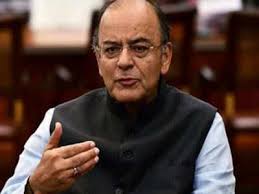Former Union Finance Minister Arun Jaitley on the second anniversary of Good & Services Tax (GST) said that the new tax regime in these two years have proved to be both consumer and assessee friendly.
Arun Jaitley, who had introduced the Goods and Services Tax (GST) on July 1, 2017, wrote in a blog that: “After two years, one can confidently argue, without fear of contradiction that GST proved to be both consumer and assessee friendly. The high taxation of the pre-GST era pinched the consumers’ pocket and acted as a disincentive against tax compliance. The last two years have seen each of the meetings of the GST Council reducing the tax burden on consumers as the tax collections improved.”
“An efficient tax system certainly leads to better compliance. The 31 percent tax, which was temporarily 28 percent, has seen the largest single reform. Most items of consumer use have been brought in the 18 percent, 12 percent and even 5 percent category. Only luxury and sin goods remain in addition to some white goods,” he added.
Responding on various misconceived ideas over GST he said: “Many warned us that it may not be politically safe to introduce the GST. In several countries, governments lost elections because of the GST. India had one of the smoothest transformations. Within the first few weeks of the implementation, the new system settled down. “
On Simplification and compliance, he said, “Businesses up to an annual turnover of Rs 40 lakh are GST exempt. Those with a turnover up to Rs 1.5 crore can make use of the composition scheme and pay only one percent tax. There is now a single registration system that works online and the procedures for the trade and business are reviewed and simplified regularly.”
Shedding the light on the pre-GST era, he said: “The GST merged all these seventeen different laws and created one single taxation. The pre-GST rate of taxation as a standard rate for VAT was 14.5 percent, excise at 12.5 percent and added with the CST and the cascading effect of tax on tax, the tax payable by the consumer was 31 percent. The GST changed this scenario completely. Today, there is only one tax, online returns, no entry tax, no truck queues, and no inter-state barriers.”
Highlighting the work of GST Council he said: “The GST the council is India’s first statutory federal institution. The Centre and the States jointly sit and decide. Both have pooled their fiscal rights in a collective forum to create one common market. My own experience of two years while chairing the GST Council, was that Finance Ministers’ of States, notwithstanding the political position their parties take, have displayed a high level of statesmanship and acted with maturity. The Council worked on the principle of consensus.”
Elets The Banking and Finance Post Magazine has carved out a niche for itself in the crowded market with exclusive & unique content. Get in-depth insights on trend-setting innovations & transformation in the BFSI sector. Best offers for Print + Digital issues! Subscribe here➔ www.eletsonline.com/subscription/



















